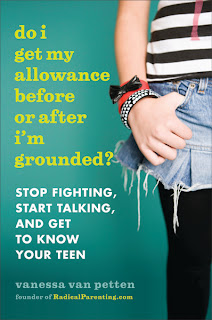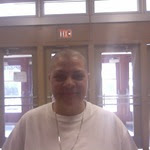Reading Student’s Non-Verbal Cues
I'd like to introduce you to my first guest blogger, Vanessa Van Petten, creator and of RadicalParenting.com and author. Vanessa wrote her first book at 17 "You're Grounded!: How to Stop Fighting and Make the Teenage Years Easier" She continues her mission to help teens and their parents understand each other with her second book.
Reading Student’s Non-Verbal Cues
By Vanessa Van Petten, creator of RadicalParenting.com and author of the parenting book, “Do I Get My Allowance Before or After I’m Grounded?”
Teachers are often the great interpreters of the younger generations—always having to read, converse
with and mentor their students. At RadicalParenting.com—a website for adults written by teens and kids to give them a secret view into the minds of teens and tweens we write about how important teachers are in young people’s lives.
One of the most important aspects of this teacher-student relationships is reading non-verbal cues. In my book, Do I Get My Allowance Before or After I’m Grounded I give tips for parents and teachers on how to read the non-verbal cues of the kids, tween and teens in their lives. Here are a few I share:
Battle Stance
Battle Stance is when someone stands with their feet wide, hands on their hips and shoulders square. It usually means they feel attacked and are going on the defensive. If a teacher or parent sees this they can immediately diffuse this subconscious state by taking a casual tone and ask the person to sit down or go to another room. This tells them they do not need to feel attacked and physically removes them from a defensive state.
Fear vs. Surprise
In my presentations and articles on Social and Emotional Intelligence I often reference microexpressions. A microexpression is a brief, involuntary facial expression that is shown on the face of humans according to the emotions that are being experienced. Unlike regular pro-longed facial expressions, it is difficult to fake a microexpression. They often occur as fast as 1/15 to 1/25 of a second. There are seven universal microexpressions: disgust, anger, fear, sadness, happiness, surprise, and contempt. In terms of lying, I believe that fear and surprise are the most important ones for parents to recognize. After all, if you ask your teen, “Did you know about the cheating incident at school?” A fearful microexpression will tell you something very different than if they look surprised.
Surprise:
-The brows are raised and curved
-Skin below the brow is stretched
-Horizontal wrinkles across the forehead
-Eyelids are opened, white of the eye showing above and below
-Jaw drops open and teeth are parted but there is not tension or stretching of the mouth
Fear:
-Brows are raised and drawn together, usually in a flat line
-Wrinkles in the forehead are in the center between the brows, not across
-Upper eyelid is raised, but the lower lid is tense and drawn up
-Upper eye has white showing, but not the lower white
-Mouth is open and lips are slightly tensed or stretched and drawn back
If you liked these tips and are interested in learning more about the non-verbal cues of kids, tweens and
teens please check out my book “Do I Get My Allowance Before or After I’m Grounded?”
References:
Paul Ekman (1999). Basic Emotions. In T. Dalgleish and M. Power (Eds.). Handbook of Cognition and
Emotion. Sussex, U.K.: John Wiley & Sons, Ltd.
"The lie detective: San Francisco psychologist has made a science of reading facial expressions" by Julian Guthrie, San Francisco Chronicle, Monday, September 16, 2002.
Book: Why Kids Lie: How Parents Can Encourage Truthfulness
Reading Student’s Non-Verbal Cues
By Vanessa Van Petten, creator of RadicalParenting.com and author of the parenting book, “Do I Get My Allowance Before or After I’m Grounded?”
Teachers are often the great interpreters of the younger generations—always having to read, converse
with and mentor their students. At RadicalParenting.com—a website for adults written by teens and kids to give them a secret view into the minds of teens and tweens we write about how important teachers are in young people’s lives.
One of the most important aspects of this teacher-student relationships is reading non-verbal cues. In my book, Do I Get My Allowance Before or After I’m Grounded I give tips for parents and teachers on how to read the non-verbal cues of the kids, tween and teens in their lives. Here are a few I share:
Battle Stance
Battle Stance is when someone stands with their feet wide, hands on their hips and shoulders square. It usually means they feel attacked and are going on the defensive. If a teacher or parent sees this they can immediately diffuse this subconscious state by taking a casual tone and ask the person to sit down or go to another room. This tells them they do not need to feel attacked and physically removes them from a defensive state.
Fear vs. Surprise
In my presentations and articles on Social and Emotional Intelligence I often reference microexpressions. A microexpression is a brief, involuntary facial expression that is shown on the face of humans according to the emotions that are being experienced. Unlike regular pro-longed facial expressions, it is difficult to fake a microexpression. They often occur as fast as 1/15 to 1/25 of a second. There are seven universal microexpressions: disgust, anger, fear, sadness, happiness, surprise, and contempt. In terms of lying, I believe that fear and surprise are the most important ones for parents to recognize. After all, if you ask your teen, “Did you know about the cheating incident at school?” A fearful microexpression will tell you something very different than if they look surprised.
Surprise:
-The brows are raised and curved
-Skin below the brow is stretched
-Horizontal wrinkles across the forehead
-Eyelids are opened, white of the eye showing above and below
-Jaw drops open and teeth are parted but there is not tension or stretching of the mouth
Fear:
-Brows are raised and drawn together, usually in a flat line
-Wrinkles in the forehead are in the center between the brows, not across
-Upper eyelid is raised, but the lower lid is tense and drawn up
-Upper eye has white showing, but not the lower white
-Mouth is open and lips are slightly tensed or stretched and drawn back
If you liked these tips and are interested in learning more about the non-verbal cues of kids, tweens and
teens please check out my book “Do I Get My Allowance Before or After I’m Grounded?”
References:
Paul Ekman (1999). Basic Emotions. In T. Dalgleish and M. Power (Eds.). Handbook of Cognition and
Emotion. Sussex, U.K.: John Wiley & Sons, Ltd.
"The lie detective: San Francisco psychologist has made a science of reading facial expressions" by Julian Guthrie, San Francisco Chronicle, Monday, September 16, 2002.
Book: Why Kids Lie: How Parents Can Encourage Truthfulness


Comments